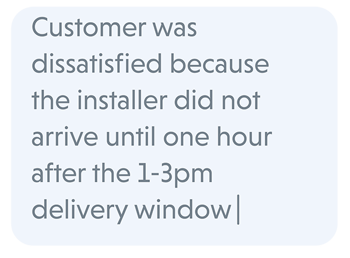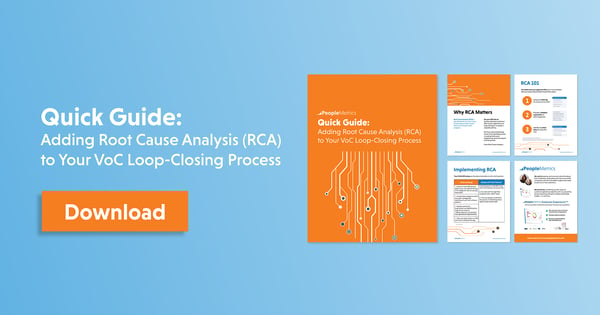What is Root Cause Analysis (RCA)?
Root Cause Analysis (RCA) is identifying the true root cause of each recover alert.
What you are doing is identifying what is really causing your customers to indicate there was a problem or why they are now a detractor.
RCA asks, “What was the fundamental issue that caused the customer to not recommend you, have a poor recent experience, or indicate that they may take their business elsewhere?”
After running RCA for a few weeks, you’ll begin to see patterns emerge, and often a single root cause will stand above the rest.
How RCA Works
The extra steps required for root cause analysis can powerfully improve ROI. Without help from a VoC partner, though, the task may look daunting.
Here’s how it works at PeopleMetrics:
First, we analyze several hundred recover alerts that have been generated over the past few months.
We then create five to ten broad root cause categories that we find are behind most of the recover alerts. We review and refine this list with our client to make sure these categories make sense.
Next, we include these root cause categories as “tags” in our alert management system that our clients use to manage their recover alerts.
Finally, we require a root cause tag to be chosen before any recover alert can be considered "closed" by the client.
Here are some examples of root cause tags: 
While this sounds simple, it takes discipline to ensure that every single recover alert is coded within one of these RCA categories.
Once a root cause tag is chosen, best practice is to require the loop-closer to include a detailed reason for what happened. This is an open-ended text box that pops up after a root cause is chosen:

The process of requiring a detailed explanation that is tied to each root cause identified is critical to understanding what happened.
RCA Taken to Another Level
So you have identified the right root cause tags, have a process for each recover alert to be followed up on by a member of your team, and detailed explanation provided for each alert.
What’s next?
Including the operational improvement or action that was taken for each recover alert in your loop-closing process.
Push yourself to go beyond “called customer” or “gave discount for next purchase,” (although these are important to track too). To get true value, focus on action tags that are about truly improving operations going forward.
So, items such as “escalated to management team” or “directed CSR for training” provide directives that help prevent future recover alerts from occurring!

And remember that quantitatively reporting root cause tags and actions provides another level of insight.
For example, you can now know the root causes of detractors vs. passives and what operational actions are most appropriate for each.
With RCA data properly analyzed, you will be able to identify what we call systemic issues—the kind that, if improved, can make a big impact across your entire organization, not just one customer!
RCA is a game changer.
○ ○ ○
About the Author
Sean McDade, PhD is the author of Listen or Die: 40 Lessons That Turn Customer Feedback Into Gold. He founded PeopleMetrics in 2001 and is the architect of the company’s customer experience management (CEM) software platform. As CEO, he guides the company’s vision and strategy. Sean has over 20 years of experience helping companies measure and improve the customer experience. Earlier in his career, he spent five years at the Gallup Organization, where he was the practice leader of their consulting division. His company offers CEM software with advanced machine learning solutions and hands-on analytical support to help companies make sense of their CX data. Sean holds a Ph.D. in Business Administration with a specialization in marketing science from Temple University in Philadelphia. He has published eight articles in peer-reviewed scholarly journals and has taught over 25 marketing classes. Sean was named a 40 under 40 award recipient of the Philadelphia region. He is an active Angel Investor, including investments in Tender Greens, CloudMine and Sidecar.
Topic: Alert Management






%20(1).png)